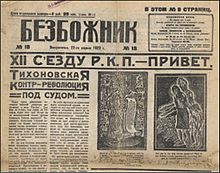Bezbozhnik (magazine)

22 April 1923 issue of Bezbozhnik
|
|
| Type | Daily newspaper |
|---|---|
| Format | Broadsheet |
| Founded | 1922 |
| Language | Russian |
| Ceased publication | 1935 |

Cover showing the gods (of Judaism, Christianity and Islam) being crushed by the First Five-Year Plan.
|
|
| Categories | Satirical magazine |
|---|---|
| Frequency | Monthly |
| Company | League of Militant Atheists |
| Country | Soviet Union |
| Language | Russian |
Bezbozhnik (Russian: Безбожник; "The Godless") was a anti-religious and atheistic newspaper published in the Soviet Union between 1922 and 1941 by the League of Militant Atheists. Its first issue was published in December 1922, with a print run of 15,000, but its circulation reached as much as 200,000 in 1932.
Between 1923 and 1931, there was also a magazine called Bezbozhnik u Stanka (Безбожник у станка; "The Godless at the Workbench").
Initially, the publication ridiculed all religious belief as being a sign of ignorance and superstition, while stating that religion was dying in the officially atheist Soviet Union, with reports of closing churches, unemployed priests and ignored religious holidays. Starting in the mid-1920s, the Soviet government saw religion as an economic threat to the peasantry, whom, it said, were being oppressed by the clergy.
Its main targets were Christianity and Judaism, accusing rabbis and priests of collaborating with the bourgeoisie and other counter-revolutionaries (see White movement). The rabbis were accused of promoting hostility between Jews and Gentiles. Bezbozhnik alleged that some rabbis in the tsarist government's pay had helped organize anti-Jewish pogroms, while claiming that such actions had sparked similar atrocities in England, South Africa and other countries.
Priests were attacked by being parasites who lived off the work of the peasants. It reported about priests it said had admitted deceiving peasants and priests it said had renounced their profession. For instance, it ran a story about a certain Sergei Tomilin, who claimed 150 kilograms of wheat and 21 metres of linen for each marriage he conducted, performing over 30 marriages in just a few weeks and thus receiving the wage a schoolteacher would have earned in 10 years.
...
Wikipedia
